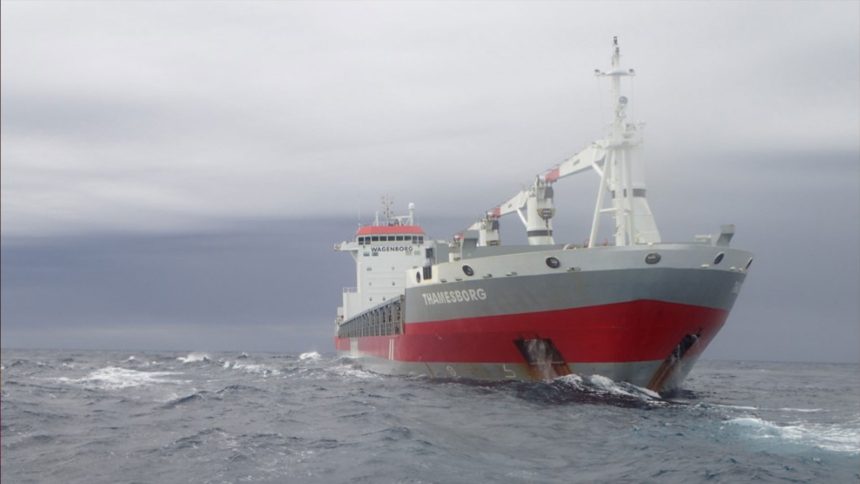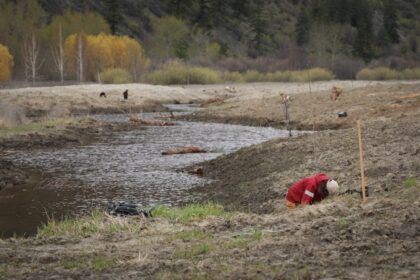The first stage of salvage operations has begun on the Dutch cargo ship the MV Thamesborg, five weeks after it ran aground in the Northwest Passage on Sept. 6. “Around 4,000 tons of cargo aboard the Thamesborg has been transferred to [other vessels],” explained David Solsbery, spokesperson for Royal Wagenborg, the Dutch owner of the Thamesborg. “This stage of the operation was needed to reduce the draft of the vessel for an upcoming refloating attempt. Should it be determined to be necessary, we have the resources on location to remove additional cargo and further lighten the ship.” The Canadian Coast Guard has reviewed Royal Wagenborg’s plan to salvage the ship and declared it reasonable and appropriate. “All preparatory salvage operations to date have proceeded without incident,” Solsbery said. Though multiple ballast tanks ruptured when the vessel ran aground, they were empty, and have filled with seawater. On Oct. 3, the Estonian ship MSV Botnica arrived at the Thamesborg’s grounding site in the Franklin Strait, Nunavut, off the Boothia Peninsula. It carried the last of the equipment necessary for Stage 2 of the salvage endeavour. “With this equipment, the amount of ballast water in the damaged tanks will be reduced in a controlled way,” Solsbery explained. “Conditions permitting, the refloating operation is scheduled for this week.” After refloating, Stage 3 of the salvage process will see the vessel inspected and head toward a port of refuge, yet to be confirmed. “The current plan is for the Thamesborg to make this voyage under its own power,” Solsbery said. “However, the Botnica is available to assist by escorting, towing, or icebreaking. The Thamesborg has an ICE Class 1A notation, which translates to having engine output and other properties that are capable of navigating in difficult ice conditions, with the assistance of icebreakers when necessary.” Read more: Salvage work begins on ship grounded in Northwest Passage north of Gjoa Haven, Nunavut For this to work, Solsbery acknowledged, salvage teams will need calm weather and sea conditions. “[As well as] the continued safety of the crew and all responding personnel,” he said, “maintaining the integrity of the ship and local environment will remain our key priorities, regardless of time pressures.” Solsbery said Royal Wagenborg is pouring “all company resources and energy” into making sure the Thamesborg is refloated before the region ices over. He added the company has contingency plans in place for dealing with ice should the ship become locked in the Strait as it freezes up. According to Kevin Tatryn, the Canadian Ice Service’s senior meteorologist, there is currently no sea ice at the Thamesborg’s location in the Franklin Strait. “There are a few icebergs floating south of the ship’s position, about 100 nautical miles south,” he said. “The closest sea ice is actually in McClintock Channel. That’s about 80 to 90 nautical miles to the west.” None of the Thamesborg’s crew of 16 was hurt in the grounding, which did not affect the ship’s fuel and cargo areas. The Coast Guard has recorded no environmental damage. Following the grounding incident, some commentators noted the area of the Franklin Strait on which the Thamesborg is stuck contains known shallows. However, in an email to APTN News, the Canadian Transportation Safety Board’s Hugo Fontaine noted the specific area is not well mapped. “The cargo vessel Thamesborg […] grounded on an object that was not indicated on the nautical chart for the area in Franklin Strait,” Fontaine told APTN. According to the company, the investigation on why it ground is ongoing. “The precise cause of the grounding is yet to be determined,” said Solsbery. “A full and thorough investigation into the circumstances leading to the grounding is underway in coordination with Canadian authorities, including the Transportation Safety Board of Canada. “Therefore, any statement made on the causes of the collision prior to the completion of this investigation would be premature.” John Coyne, director for Nunavut Emergency Management, noted his agency is not the lead in the salvage operation, which is overseen by the Coast Guard. However, Coyne said the NEM is there for support. “Our role is to maintain situational awareness and coordinate communications—through our coordination center, we’ve maintained close contact with all of our partners. And to ensure, basically, that we’re positioned to support, if the situation changes, through those normal communication pathways. We’ve stayed in touch with local governments,” he said. Sue McLennan, the Coast Guard’s regional director of Response for the Arctic Region, said the Coast Guard operating in the North was “committed to aligning our operations with the Inuit Nunangat policy and the Inuit land-claims agreement.” “We’ve made regular efforts to keep Inuit partners in nearby communities informed, including briefings to [territorial legal representative] Nunavut Tunngavik Incorporated, and weekly community notifications. We prioritize these collaborative partnerships with Inuit governments and organizations. The Canadian Coast Guard’s priority is the safety of Canadians and the protection of the marine environment.” Continue Reading
Salvage operation begins to free cargo ship Thamesborg grounded in Northwest Passage

Leave a Comment











